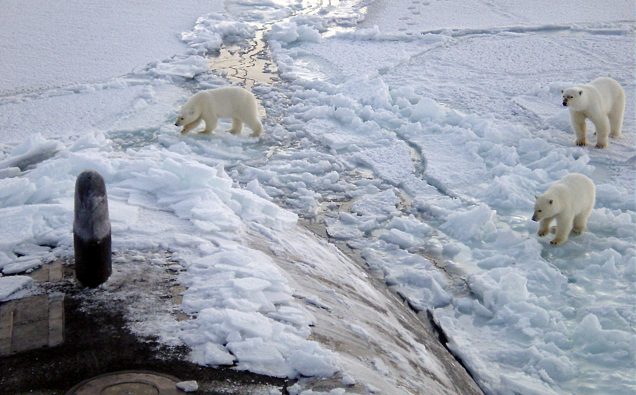
Polar Bears near North Pole, Photo by Chief Yeoman Alphonso Braggs, US-Navy via Wikimedia Commons
A heatwave blowing over the Arctic pole in winter?
Not a sci fi movie. Nor even an improbable dystonia of climatic disaster. But a bone-chilling reality.
This week, the United Nations meteorological agency made a startling disclosure that must toll the bell on climate change denial.
Arctic pole – the northern most point in the world – has experienced a swift melting of the sea ice volume to a record low in January as “equivalent of heatwaves” have passed over the region this season, the world body reported.
That is not all. There is still more scare.
The ice levels at the Antarctic are also at record lows, even thinner than expected for the summer season there.
“Temperatures in the Arctic are quite remarkable and very alarming,” said David Carlson, Director of the World Climate Research Program.
Sea ice extent was the lowest on the 38-year-old satellite record for the month of January, both at the Arctic and Antarctic, according to data cited WMO from both the US National Snow and Ice Data Center (NSIDC) and Germany’s Sea ice Portal operated by the Alfred-Wegener-Institute, the UN said.
The Arctic sea ice extent averaged 13.38 million square kilometres in January, according to NSIDC data.
This is 260,000 square kilometers below the level in January 2016 – an area bigger than the size of the United Kingdom.
“The recovery period for Arctic sea ice is normally in the winter, when it gains both in volume and extent.
“The recovery this winter has been fragile, at best, and there were some days in January when temperatures were actually above melting point,” said Carlson.
“This will have serious implications for Arctic sea ice extent in summer as well as for the global climate system. What happens at the Poles does not stay at the Poles.”
Meanwhile, a new study shows that Canada’s Arctic glaciers are also losing ice rapidly, causing global sea level rise.
Between 2005 to 2015, surface melt off ice caps and glaciers of the Queen Elizabeth Islands grew by 900 percent, according to findings cited in the media and published last week in the journal Environmental Research Letters.
Canada is home to 25 percent of all Arctic ice, second only to Greenland, which is also seeing the ice melt under greenhouse gases.

















